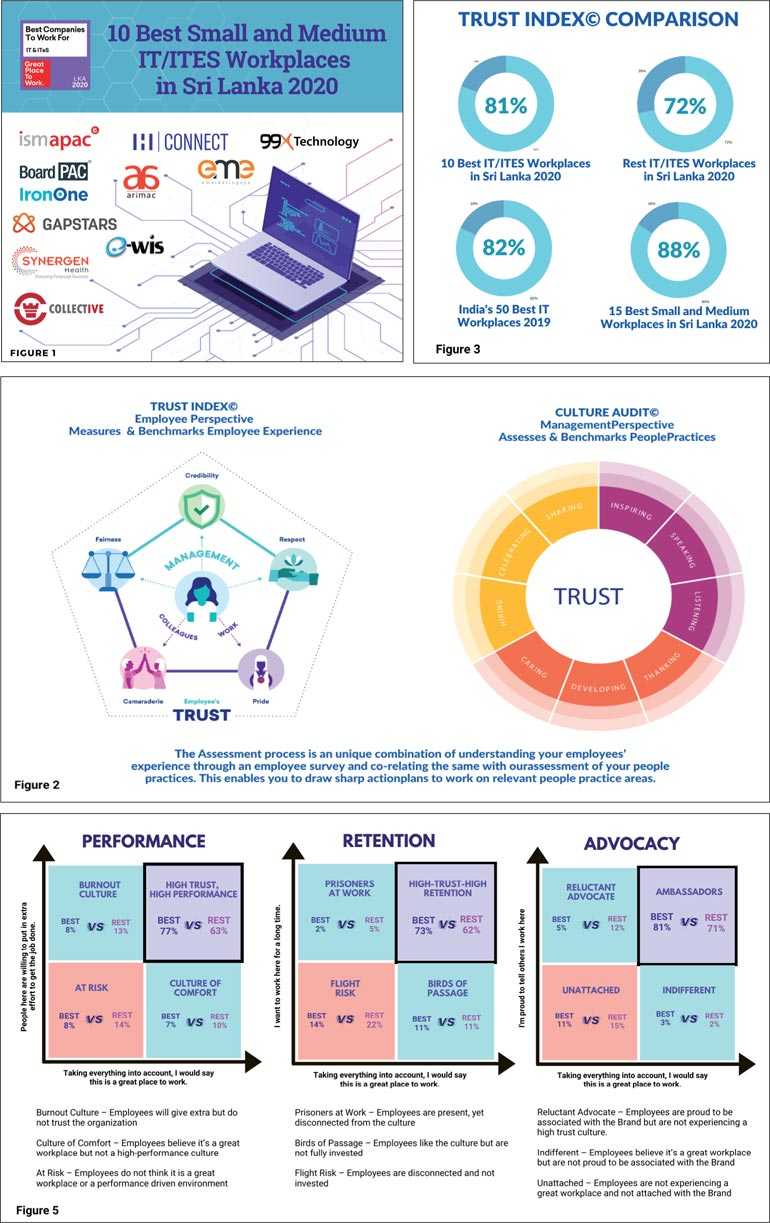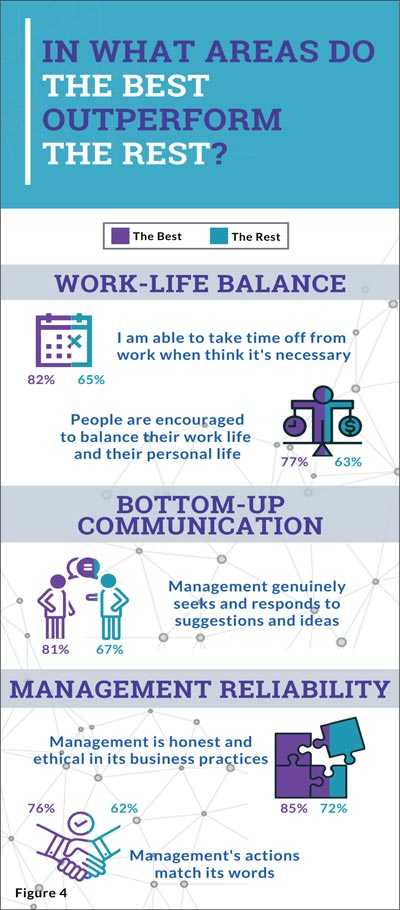Sunday Dec 14, 2025
Sunday Dec 14, 2025
Wednesday, 6 May 2020 00:28 - - {{hitsCtrl.values.hits}}

 In a time when Information Technology is the lifeblood of the global economy, the sector which is keeping alive those businesses which are able to adapt to remote function during the COVID-19 lockdown, it seems fitting to recognise those which have shown themselves to be the Best Workplaces among the SMEs in the IT/ITES sector of Sri Lanka.
In a time when Information Technology is the lifeblood of the global economy, the sector which is keeping alive those businesses which are able to adapt to remote function during the COVID-19 lockdown, it seems fitting to recognise those which have shown themselves to be the Best Workplaces among the SMEs in the IT/ITES sector of Sri Lanka.
The ICT Industry in Sri Lanka has seen a rapid expansion in the last 5 years, rising to become the country’s fourth largest export earner with a goal of becoming a $ 5 billion industry by 2022. This goal would also create 200,000 direct employment opportunities and 1000 start-ups. In addition to competing comparatively with her long-established neighbour India, as an offshoring service provider, what sets Sri Lanka apart and continues to draw the attention of international corporations is the wealth of talent of the workforce. Agility, value for investment, and cultural adaptability are some of those key areas where Sri Lanka provides superior quality, however the key ingredient has been the innovation and commitment of the employees in this sector.
With this sector being one of the few which are expected to flourish and not suffer considerably from the demand shock of the impact of COVID-19, the IT/ITES organisations will do well to understand how best to encourage this innovative spirit and support their people in excelling at their jobs. This will be specifically relevant to SMEs who will perhaps find it more difficult to weather the shocks of the lockdown and the resulting downturn in the global economy.
Great Place to Work in Sri Lanka has compiled its inaugural list of the Best Small and Medium IT/ITES Workplaces. The list comprises of organisations that have been Great Place to Work – Certified™ and showcases areas in which these organisations perform better than the others assessed in the same sector.
Approximately 4000 employees from organisations with employees ranging from 20 to 500, were surveyed in 2019-2020, measuring employee perception and organisation practices. Analysis included comparison of the “Best 10 SMEs in IT/ITES” to the “Rest of SMEs in IT/ITES” and benchmarking against “Sri Lanka’s Best 15 SMEs (2020)” and “India’s Best 50 in IT (2019)”. The list is being published in random order (Figure 1).
 Assessment methodology
Assessment methodology
The Great Place to Work model (Figure 2) used to assess Best Workplaces is based on two lenses. Firstly, the Trust Index employee perception survey is conducted to understand the employee workplace experience. Organisations are measured on whether employees TRUST the people they work for, have PRIDE in the work they do and share CAMARADERIE among people they work with. Secondly, the practices in place to drive the employee experience are evaluated through a central submission termed the Culture Audit. Results for each of the listed organisations are audited to maintain accuracy and validity of its inclusion in the Best Workplaces List.
Great Place To Work model (Source: Great Place to Work)
Eligibility Criteria:
In order to arrive at the 10 Best Small and Medium IT/ITES Workplaces in Sri Lanka 2020, 60% weightage was given to the experience of employees and 40% weightage was given to the people practices in the organisation, with priority given to the areas of Listening, Collaborating, Developing, Balancing, Supporting, Hiring and Including.
The average Trust Index scores for the List and related Lists are represented in Figure 3.
Key differentiators of the Best vs. the Rest
The Best 10 in IT/ITES outperform the Rest by an average of 9 percentage points. These organisations also maintain a positive perception nearly on par with that of the average among the Best in IT in India. However, in comparison to other SMEs in other industries among best workplaces in Sri Lanka, the Best in IT/ITES still have room to improve. Analysis of employee perceptions scores represent the overall employee experience, with the areas of notably higher scores being presented in Figure 4.
In addition, the scores of the Best 10 indicate the below areas of strength.
High levels of trust lead to high performance
A good employee experience is a great result for engagement. However, how do these high scores translate to business performance indicators? Comparing the scores of key organisational health indicators demonstrates the connections between workplace culture and business performance.
Where trust translates to performance
The representative matrices (Figure 5) indicate the comparative scores of the Best Workplaces to the Rest of the IT/ITES organisations, where the ideal scenario will show the majority in the upper right quadrant, and the least in the two left quadrants, which show that trust-building is required.
A greater number of employees who are willing to put in that extra effort and stay committed to the organisation for a long time will result in a dedicated workforce who are invested in the results of the organisation, leading to a High Trust, High Performance Culture.
Those that speak well of their workplace to the external community will increase the brand value of the organisation and attract more talent to the organisation through advocacy.
Demographic insights
The demographic breakdown of the participants allows the identification of key areas corresponding to different groups of employees. Overall, across all demographics, Non-Discrimination was perceived well, specifically with respect to gender and age. This is a promising indicator in creating a more inclusive workforce. Additionally, results worth noting are the perceptions of women and millennials.
Women
The overall female representation among the Sri Lankan IT/ITES organisations assessed is 37%, which is greater than that of 25% among IT/ITES organisations assessed in India, as well as 28% among the Best 15 Non-IT SMEs in Sri Lanka. However, this includes non-tech related positions, such as admin and HR. This can be further improved to reach the best case 49–51% scenario to ensure a diverse workforce which would result in a greater variety of ideas generated and more innovative thinking (ILO, 2019).
The UN’s Sustainable Development Goal (No. 5) on gender equality monitors the number of women in managerial roles. The current global representation is 27% with no notable increase over the last 5 years. It was observed that among the 10 Best SME Workplaces in IT/ITES in Sri Lanka, 28% of managerial roles belong to women. Comparatively, the Best 15 SMEs in Sri Lanka have lower representation at 26%. However, in order to make a significant gain on this target, more effort needs to be directed towards attracting women employees and ensuring that the workplace culture is conducive to upward mobility.
Even among the 10 Best SME Workplaces in IT/ITES in Sri Lanka, the female perception was found to be relatively lower than male perception in the following themes and therefore are areas for improvement.
Millennials
While the age demography of 26 – 34 years is 46%, of the IT/ITES workforce, this segment has the lowest perception amongst all employees assessed within the study, and when compared to the benchmarks (Figure 6).
Notably, the IT/ITES sector continues to struggle to attract an adequate number of new graduates, with ICT being only the 7th highest sector attracting less than 5% of graduates (Labour Force Survey, Sri Lanka). With the outlook of the sector, it is imperative that their areas of concern are addressed. These are:
Areas of relatively high perception for Millennials were noted as workplace facilities, camaraderie, fun at work and pride for the organisation.
People practices
As the organisation’s “People Practices” contribute to enhancing and driving a better employee experience, presented below are some examples of best practices.